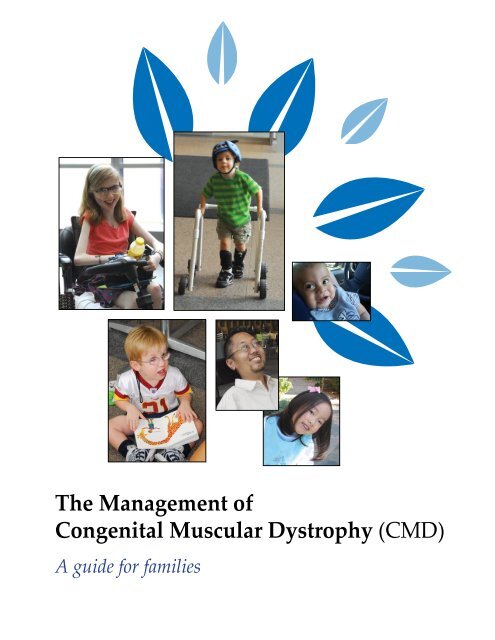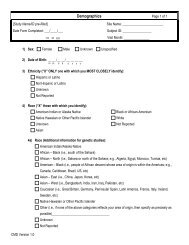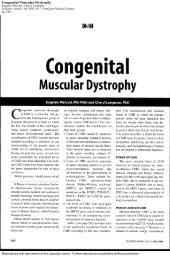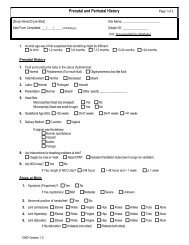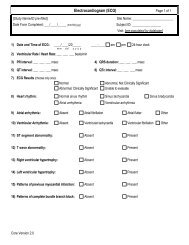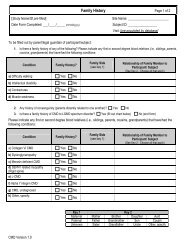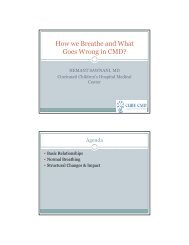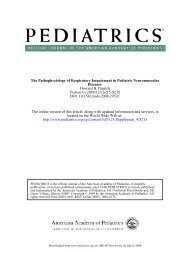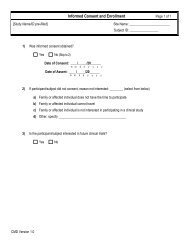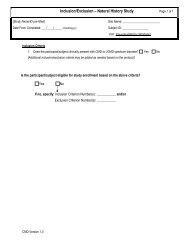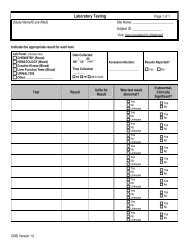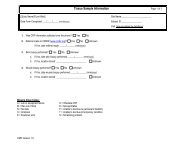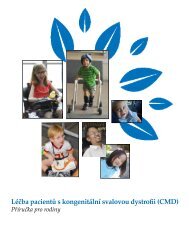The Management of Congenital Muscular Dystrophy ... - Cure CMD
The Management of Congenital Muscular Dystrophy ... - Cure CMD
The Management of Congenital Muscular Dystrophy ... - Cure CMD
You also want an ePaper? Increase the reach of your titles
YUMPU automatically turns print PDFs into web optimized ePapers that Google loves.
Box 1<strong>CMD</strong>-LGMD Subtypes(abbreviations in bold and italics used throughout guide)Collagen VI related myopathy (also known as COL6-RM) Ullrich congenital muscular dystrophy (U<strong>CMD</strong>)Intermediate phenotypeBethlem myopathy (later onset)Laminin 2 related dystrophy (also known as LAMA2-RD, includes LAMA2-<strong>CMD</strong>,MDC1A, Merosin deficient <strong>CMD</strong>)Ambulatory status as related to Laminin 2 staining on muscle or skin biopsycomplete deficiency - typically nonambulatory* (early onset)partial deficiency - typically ambulation achieved* (later onset)* note that there are exceptions - LAMA2-<strong>CMD</strong> refers to early onset non-ambulatorywhile LAMA2-RD includes those children and adults with a late onset and ambulatorypresentationAlpha-dystroglycan related dystrophy (also known as DG-RD, dystroglycanopathy,dystroglycanopathy) Walker-Warburg syndromeMuscle-eye-brain/Fukuyama like<strong>CMD</strong> with cerebellar involvement; cerebellar abnormalities may include cysts,hypoplasia, and dysplasia<strong>CMD</strong> with mental retardation and a structurally normal brain on imaging; thiscategory includes patients with isolated microcephaly or minor white matterchanges evident on MRI<strong>CMD</strong> with no mental retardation; no evidence <strong>of</strong> abnormal cognitivedevelopmentLimb-girdle muscular dystrophy (LGMD) with mental retardation (later-onsetweakness) and a structurally normal brain on imagingLGMD without mental retardation (later-onset weakness)SEPN1 related myopathy (also known as SEPN1-RM, rigid spine muscular dystrophy,RSMD1) May also be diagnosed as multi-minicore disease, desmin related myopathy withMallory body inclusions and congenital fiber-type disproportion (all musclebiopsy morphologic diagnoses that do not directly correlate with a single geneticdiagnosis)3(continued on page 4)4
Box 1 continuedRYR1 related myopathy (also known as RYR1-RM, includes RYR1-<strong>CMD</strong>)Overlaps with RYR1 related myopathies (RYR1-RM), central core andcentronuclear myopathyConsidered <strong>CMD</strong> if muscle biopsy is dystrophic without typical central coresLMNA related dystrophy (also known as LMNA-RD, includes L-<strong>CMD</strong>, LMNA-<strong>CMD</strong>) Dropped head syndrome, foot-drop, non-ambulatoryAmbulatory presentation may be called early-onset Emery-Dreifuss musculardystrophy.This demonstrates L-<strong>CMD</strong> is a part <strong>of</strong> the LMNA related Dystrophies which includesDropped head syndrome L-<strong>CMD</strong>, Ambulatory L-<strong>CMD</strong> and Emery-Dreifuss.<strong>CMD</strong> UndiagnosedPeople with <strong>CMD</strong> may carry a clinical diagnosis <strong>of</strong> <strong>CMD</strong> without geneticconfirmation. While clinical presentation and/or muscle biopsy are consistentwith <strong>CMD</strong>, genetic testing may not provide a diagnosis as not all <strong>CMD</strong> geneshave been discovered. Genetic testing under the guidance <strong>of</strong> a <strong>CMD</strong> expert isencouraged.(Continued from page 2)Some <strong>of</strong> the known genetic mutations causemuscles to break down faster than they canrepair or grow, leading to muscular weakness.A child with <strong>CMD</strong> may also have differenttypes <strong>of</strong> neurologic or physical problemsrelated to the <strong>CMD</strong>. Some children walk bythemselves or with supports; other childrenlearn how to walk but then become weakerand stop walking; and some others maynever walk at all.Children who acquire the ability to walkor those who first have symptoms in latechildhood or adulthood may be referred toas having Limb Girdle <strong>Muscular</strong> <strong>Dystrophy</strong>(LGMD). All <strong>CMD</strong> subtypes are on a spectrumwith <strong>CMD</strong> (early onset, weaker) on one endand LGMD (later onset, milder) on the other.Box 1 lists the known subtypes <strong>of</strong> <strong>CMD</strong>.See Appendix A for a full description.It is important to remember that notall people with <strong>CMD</strong> have all thesymptoms or need all the treatments youwill read about in this guide.Although there may be similarities, eachperson’s course with <strong>CMD</strong> will be uniquewith differing needs atdifferent points in time. This means caremust be individualized and it maybe difficult to meet someone whose <strong>CMD</strong>is exactly the same.How to Use this Document4 5
Hospital CareYour child may require unplanned hospitalizations(see Table 1). Your child’s pediatric neuromuscularspecialist or neurologist may play amajor role in coordinating medical care duringany acute or critical illness, though this role mayalso be played by your pediatric pulmonologist.Symptoms <strong>of</strong> <strong>CMD</strong> that may result in acutehospitalization and their associated <strong>CMD</strong> subtypesSymptom RequiringHospitalizationBreathing problemsrequiring breathingsupportHeart failure orarrhythmias requiringmedicationsSubtypes that May HaveIssues in Infancy (Early)Table 1DG-RDLAMA2-RDFeeding problems LAMA2-<strong>CMD</strong>**requiring gastrostomy RYR1-RM(G-tube) DG-RDSeizures requiring DG-RDmedication(includingFukuyama, WWS,MEB)Malignant hyperthermia SEPN1-RM RYR1-RMSubtypes with Issues inChildhood toAdolescence COL6-RM SEPN1-RMDG-RD(Fukutin, FKRP,POMT1)*LAMA2-RDLMNA-RDCOL6-RMLAMA2-RDSEPN1-RMRYR1-RMAbbreviations: DG-RD, alpha-dystroglycanopathy; FKRP, fukutin-related protein <strong>CMD</strong>;LAMA2-RD, merosin-deficient <strong>CMD</strong>; MEB, muscle-eye-brain disease; POMT1, proteinO-mannosyltransferase 1; SEPN1-RM, rigid spine muscular dystrophy; WWS,Walker-Warburg syndrome; LMNA-RD, lamin A/C <strong>CMD</strong>.*Fukutin, FKRP, and POMT1 are genes that can lead to a DG-RD. <strong>The</strong> first two are morehighly associated with heart failure, although the third may also be associated with it.If one has a DG-RD caused by one <strong>of</strong> these three genes, increased cardiac surveillanceis warranted. **LAMA2-<strong>CMD</strong> is used to refer to form <strong>of</strong> LAMA2-RD (Merosin Deficiency)that presents at birth and does not achieve ambulation, while LAMA2-RD incorporatesthe milder ambulant form and early onset non-ambulant form.Common reasons for acute care hospitalization include:• respiratory infections or respiratory failure• seizures• failure to thrive (poor weight gain orexcessive weight loss).8If your child needs to have a planned hospitalization dueto surgery or a procedure that will involve the use <strong>of</strong>anesthesia, your child’s doctor should first talk withyou about the potential risks involved and then coordinatethe planning and management for the care <strong>of</strong>your child during the procedure and through recovery.
3 Neurologic <strong>Management</strong>Care <strong>of</strong> Seizures and Cognitive ImpairmentVarious neurologic symptoms are related tosome <strong>of</strong> the known subtypes <strong>of</strong> <strong>CMD</strong>. <strong>The</strong> mostcommon are abnormalities in brain structure orfunction and seizures.Brain MalformationTwo groups <strong>of</strong> <strong>CMD</strong> are most <strong>of</strong>ten associatedwith brain abnormalities: LAMA2-RD and theαDG-RD. To evaluate for a structural brainabnormality (malformation), a magneticresonance imaging (MRI) scan <strong>of</strong> the brain isperformed.Children with αDG-RD who have normal brainstructure on MRI may or may not have a problemwith learning and cognitive function. In addition,a wide spectrum <strong>of</strong>brain MRI findings maybe found in children withαDG-RD; they can rangefrom normal to pr<strong>of</strong>ound(very severe) structuralabnormalities.<strong>The</strong> most common brainmalformation in LAMA2-RD is a white matterabnormality that is not associated with cognitiveimpairment. <strong>The</strong> white matter change is usuallystable over time and does not require repeatbrain imaging.Functional brain abnormalities associated with<strong>CMD</strong> can cause multiple problems, includingcognitive impairment; behavioral, language, andlearning problems; emotional problems; motordelays; seizures; and vision problems.If your child is believed to have a functionalbrain problem such as cognitive impairment,he or she should undergo psychometric testingand be referred to early intervention andaugmented/specialized school or communicationprograms. Communication strategies for thenonverbal or minimally verbal child need to beimplemented early and include sign language,picture or symbol cards (PECS, Picture Exchange9Communication System), voice output devices(DynaVox, TapToTalk), and ongoing speechtherapy to practice vocalization.SeizuresSeizures are frequently associated with <strong>CMD</strong>s,particularly in those children with known braininvolvement. Seizure types can include absence,atypical absence, or convulsive seizures.Seizures can start at any age from newborn toadolescence; in people who are at risk fordeveloping seizures, the seizures may beprovoked by fever and illness. Seizures may alsostart without anything known triggering them.If you have concerns about any activity orbehavior your child exhibits that you feel maybe a seizure, please discuss this with your child’shealth care provider.To determine if your child is having seizures,your child’s neurologist may recommend adetailed workup. This evaluation shouldinclude a thorough history <strong>of</strong> the events thatraise concerns that seizure activity is occurringor a history <strong>of</strong> known seizures, a comprehensiveneurologic evaluation, and at least one routineelectroencephalogram (EEG). Depending on theresults <strong>of</strong> the EEG, further or longer EEGs maybe recommended. An MRI <strong>of</strong> the brain or arepeat MRI <strong>of</strong> the brain may be recommended.<strong>The</strong> definition <strong>of</strong> epilepsy is two or moreunprovoked seizures (that is, seizures not causedby fever or illness). If your child is diagnosedwith epilepsy, the neurologist will likelyrecommend an anticonvulsant medication toreduce the frequency and severity <strong>of</strong> seizures.Seizures in children with LAMA2-RD are<strong>of</strong>ten successfully treated with a specificanticonvulsant, valproic acid, but othertreatments have also been used successfully.Occasionally seizures can be difficult to control.In children with αDG-RD, for example,management <strong>of</strong> seizures can be more difficultbecause <strong>of</strong> possible underlying structuralabnormalities. <strong>The</strong>re are many differentanticonvulsants, so if your child does notrespond to the first medicine, your neurologistmay recommend different or multiplemedications to try to control the seizures.
4 Respiratory <strong>Management</strong>Care <strong>of</strong> BreathingA primary purpose <strong>of</strong> the lungs and breathing(respirations) is to bring oxygen (O2) into theblood that circulates in the body and releasecarbon dioxide (CO2) out <strong>of</strong> the body. Thisprocess <strong>of</strong> trading O2 and CO2 is also called gasexchange; it occurs in all humans and is a criticalelement in your child’s health.<strong>The</strong> need for respiratory support for a child with<strong>CMD</strong> can vary considerably between and withineach <strong>CMD</strong> subtype. Children with all types <strong>of</strong><strong>CMD</strong> have an increased risk <strong>of</strong> developingpulmonary (lung) problems due to weakbreathing muscles. <strong>The</strong> age when breathingproblems may emerge, as well as the severity<strong>of</strong> the respiratory problems that appear, variesfrom individual to individual. Typically,breathing problems begin to be noticed betweenages 8 and 15 years. Younger children with<strong>CMD</strong> and breathing problems may not showtypical symptoms; it is important that parentsand caregivers be aware <strong>of</strong> the early signs <strong>of</strong>breathing problems. It is recommended thatonce your child has been diagnosed with <strong>CMD</strong>,he or she be evaluated by a pulmonologist to geta baseline assessment. <strong>The</strong> pulmonologist willteach you about the early signs <strong>of</strong> respiratoryproblems in young children. Your child’scoordinating provider and pulmonologist willwork with you toward effective respiratory care.Signs and SymptomsA two-step proactive approach to the care foryour child’s respiratory problems is importantin helping to maintain his or her best possiblefunctioning over time. <strong>The</strong> recognition byparents and caregivers <strong>of</strong> early signs andsymptoms, in addition to regularly scheduledpulmonary evaluations, pulmonary testing, andtreatment, is <strong>of</strong> utmost importance.Signs <strong>of</strong> early symptoms and problems with yourchild’s breathing muscles may be subtle and canchange over time. If you have concerns aboutyour child’s respiratory function, please contact10your pulmonologist. If the situation appearsurgent, have your child evaluated in theemergency room. Be on the lookout for thefollowing signs and symptoms:• weak cry• ineffective coughing• repeated respiratory infections, irregularbreathing patterns, or general irritability• choking during feedings or on theirown secretions• weight loss or poor weight gain (<strong>of</strong>tenreferred to as failure to thrive).Some additional symptoms may be relatedto problems with breathing function at night.Breathing problems may start at nightbecause this is when all humans breathe moreshallowly. <strong>The</strong>se signs can include:• interrupted sleep or an increased need toturn at night• awakening in the morning feeling tired orin disturbed mood, even when he or she hasslept for enough hours• a faster breathing rate or a feeling <strong>of</strong>breathlessness• morning headaches, nausea• poor concentration during the day• fear <strong>of</strong> going to sleep and nightmares.Curvature <strong>of</strong> the spine (scoliosis) and chestwall deformities can also develop, in partdue to weak chest muscles and a weakeneddiaphragm, which may further limit yourchild’s breathing capacity.See Orthopedics and Rehabilitation<strong>Management</strong> section.
Your child’s diaphragm muscles may beweak without producing any other obvioussymptoms. This is unique to several <strong>CMD</strong>subtypes; respiratory problems may beginwhile your child is still walking (see Table2) even though in most other forms<strong>of</strong> muscular dystrophy, respiratory problemsdo not start until after a child can nolonger walk. This fact makes it even moreimportant that your child be evaluated bya pulmonologist before symptoms are seen.Table 2Onset <strong>of</strong> typical breathing problems in known <strong>CMD</strong> subtypes<strong>CMD</strong> SubtypeOnset <strong>of</strong> Breathing ProblemsCOL6-RM Early-onset night-time breathingproblems with diaphragm weakness Breathing support needed on averageby age 11 yearsSEPN1-RM Early onset <strong>of</strong> night-time breathingproblems; may occur before losing theability to walk Breathing support needed on averageby age 10 yearsLAMA2-RD Association seen between declines inmotor function and respiratory function Breathing support needed on averageby age 11 yearsDG-RD with cognitive Severe progression <strong>of</strong> muscle weaknessimpairment (WWS, MEB,and respiratory failureFukuyama) Breathing management may start atbirth or in first decade if severe muscleweaknessDG-RD without cognitive Association seen between declines inimpairment and LGMDmotor function and respiratory functionforms Breathing management starts whenperson loses the ability to walkAbbreviations: <strong>CMD</strong>, congenital muscular dystrophy; FKRP, fukutin-related protein;LAMA2, laminin A2; LGMD, limb-girdle muscular dystrophy; MEB, muscle-eye-braindisease; SEPN1, selenoprotein; WWS, Walker-Warburg syndrome.11
Types <strong>of</strong> PulmonaryFunction Testing• Spirometry is used to document breathingfunction; this test should be done on at leastan annual basis by at least age 6 years.Spirometry testing can occur during yourchild’s regular pulmonology visit or at aseparate appointment. Most <strong>of</strong>ten thistesting is administered by a respiratorytherapist before your child’s exam withthe clinician. This noninvasive testing mayinclude the measurement <strong>of</strong> your child’sforced vital capacity (FVC) and peak coughflow; these are measured by having the childbreathe into a tube or mask. <strong>The</strong>se tests mayalso be referred to aspulmonary functiontests, or PFTs.• Nocturnal (nighttime)oximetry(“pulse ox”) painlessly measures bloodoxygen saturationlevels using a sensorattached typically to afinger or toe.Sometimes the sensor looks like a bigBand-Aid or is kept on the finger or toe withjust a piece <strong>of</strong> tape.• Polysomnography, or a sleep study, is anoutpatient overnight testing procedureconducted in a sleep lab; it is done asrecommended by your child’spulmonologist, who may recommendit on an annual basis. This test is helpfulin the monitoring <strong>of</strong> night-time respiration,and can discover if sleep apnea is presentand how severe it is. Sleep studies can alsobe used to monitor the results <strong>of</strong> bilevelpositive airway pressure (BiPAP) use and toguide adjustments to such use.• Blood gases are measured through a blooddraw. This procedure is used to measure theO2 and CO2 levels in the blood if a child ishaving new or severe breathing problems.• End-tidal CO2: This is measured using adevice that measures the CO2when a personbreathes out. It can help a pulmonologistunderstand how well a person who is onbreathing support (BiPAP or ventilator)is breathing and whether adjustments insettings need to be made. This device mayalso be used by a pulmonologist to checkCO2 levels for people with <strong>CMD</strong> who arejust starting to have breathing issues but arenot on breathing support.• A speech and swallow evaluation may beconsidered whenever there are symptomsindicating risk for aspiration, such as cough,choking, difficulty swallowing, poor feeding,or failure to thrive.Preventive Respiratory CarePneumococcal (pneumonia) and annualinfluenza (flu) vaccines are recommended forall children and adults with <strong>CMD</strong>. It is alsorecommended that Synagis, the vaccine toprevent respiratory syncytial virus (RSV), begiven to children under age 2 years.Your child will benefit from the followingmethods that improve his or her ability to movesecretions, cough efficiently, and help keeptheir airway and lungs open:• Cough assistance using a mechanicalinsufflator-exsufflator apparatus (“coughmachine,” “coughalator,” or Cough Assist)may help to remove mucus from the lowerairways.• Breath stacking techniques, as taught byyour child’s pulmonologist, may help reducethe risk <strong>of</strong> chronic collapse <strong>of</strong> areas <strong>of</strong> thelungs (atelectasis).• Chest physical therapy using a dailyintrapulmonary percussive ventilation(IPV) regimen may also assist in theclearance <strong>of</strong> secretions.• A bronchial drainage chest compressionvest (percussive vest) provides rapid chestcompression to mobilize secretions.Your child may have breathing problems due to otherfactors not related to <strong>CMD</strong>. Although asthma is nota symptom <strong>of</strong> <strong>CMD</strong>, if it is diagnosed in your child itshould be treated with bronchodilators and inhaledsteroids as needed. Treatment <strong>of</strong> asthma in childrenwith <strong>CMD</strong> is no different from treatment for childrenwithout <strong>CMD</strong>.12
InterventionsSevere scoliosis can make it harder for the lungsto expand all the way and prevent a person fromtaking a “deep breath.” Your child may requirespinal bracing to slow the progression <strong>of</strong>scoliosis and maintain improved postureduring daily activities. When bracing is used itis important to consider its effect not only on thescoliosis, but also on the child’s breathing. Eachbrace needs to be evaluated to make sure it doesnot have a potentially negative effect onbreathing function. Your child’s orthopedistand pulmonologist should work together toensure that the brace is supportive enough forthe spine and doesn’t worsen breathing function.To assist with difficulties with effective breathing,your child’s clinician may recommend theuse <strong>of</strong> supportive breathing equipment(noninvasive or ventilator equipment), whichhas been shown to improve gas exchange,decrease chest infections, and decrease thefrequency and duration <strong>of</strong> hospital stays.Noninvasive ventilation is most commonlyrecommended when there is evidence <strong>of</strong>hypoventilation (weak breathing ability) or forany <strong>of</strong> the resulting signs and symptoms <strong>of</strong>respiration problems. Noninvasive ventilationtechniques are provided through a mask orother easily removable device.Bi-PAP (bilevel positive airway pressure) is acommonly used noninvasive ventilator usuallybegun for night-time support. It consists <strong>of</strong> asmall machine that pumps air through tubingconnected to an interface or mask that goes overyour child’s nose or mouth. Pressurized air thatsupports your child’s breath helps remove CO213when breathing out. A variety <strong>of</strong> interfaceoptions are available, based on your child’s age,skin condition, face shape, and ability to toleratethis intervention.Once your child begins to use noninvasive ventilation,he or she will need to undergo overnightmonitoring (sleep study), at least annually, toadjust ventilator settings and to check and adjustthe fit <strong>of</strong> the mask or other interface.Special care should be directed to the youngchild receiving long-term ventilation to helpaddress the potential complications <strong>of</strong> abnormalfacial development (midface hypoplasia). <strong>The</strong>use <strong>of</strong> individually fitted masks or alternatingbetween nasal pillows, nasal masks, and full facemasks may be helpful in preventing thiscomplication. Sip ventilation with a mouthpiecemay also be recommended for people whorequire breathing support during the day.Sometimes long-term mechanical ventilationmay need to be delivered via a surgically placedtube in the neck, called a tracheostomy tube.Indications for this include chronic aspirationwith repeated pneumonias or ineffectiveclearing <strong>of</strong> airway secretions despite the use <strong>of</strong>assistive interventions. Some people also prefera tracheostomy tube if they require noninvasiveventilation for the majority <strong>of</strong> the day and night.<strong>Management</strong> <strong>of</strong> AcuteRespiratory IllnessRespiratory tract infections (common cold andpneumonia) are the most frequent cause <strong>of</strong>hospital admissions and life-threateningsituations in individuals with <strong>CMD</strong>. When anacute respiratory infection is suspected, it isimportant to have your child evaluated, makingsure that you tell the clinician the type <strong>of</strong> <strong>CMD</strong>your child has and what you know about thedisease course.Signs <strong>of</strong> acute respiratory distress can besubtle but may include:• paleness• increased sleepiness• decreased appetite• unusual movement <strong>of</strong> chest and belly
• fast heart rate or breathing rate• weak cough• increasing fatigue.Any <strong>of</strong> these signs deserve a careful evaluationbut if, in addition, the oxygen saturation is lessthan 94% or is lower than your child’s baseline,your child should be seen by his or her medicalprovider or evaluated in the emergencydepartment immediately.To evaluate the severity <strong>of</strong> your child’s illness,the clinician will perform a physical exam andlisten to your child’s chest. Other diagnosticmethods may include:• assessment <strong>of</strong> cough effectiveness• pulse oximetry and possible CO2measurement to evaluate breathingproblems• chest X-ray to identify pneumonia andcollapsed areas <strong>of</strong> lungs (comparisonwith previous films may be needed forthe most accurate evaluation)• sputum culture if your child is able toproduce mucus by coughing; this culturemay provide information about the type<strong>of</strong> bacteria causing the pneumonia.Treatment <strong>of</strong> your child’s acute respiratoryinfection aims at maintaining stable breathingfunction.Antibiotics should be used in most respiratoryinfections to treat potential underlying bacterialpneumonia in <strong>CMD</strong> with ongoing monitoring <strong>of</strong>respiratory status if pneumonia is diagnosed.If your child’s oxygen saturation is low,supplemental O2 should be provided (sometimesthrough a nasal cannula or mask). However, itis important to note that if there is evidence <strong>of</strong>CO2 retention it is more appropriate to provideventilator support rather than O2 alone.If there are signs <strong>of</strong> respiratory failure and yourchild is not yet using noninvasive ventilationsupport, this should be initiated. If your child isalready using breathing support, re-evaluation <strong>of</strong>his or her ventilator settings or an increase in thenumber <strong>of</strong> hours the child uses it may benecessary to stabilize your child’s breathingfunction. In more serious illnesses, intubationmay be required if noninvasive ventilation is nothelpful, your child is unable to clear secretions,or your child is losing the ability to protect his orher airway, increasing the risk <strong>of</strong> aspiration.Treatments to help mobilize your child’ssecretions should be intensified, including use<strong>of</strong> a cough machine, IPV, chest insufflations, andmanually assisting hie or her cough. Bronchodilatorsand chest percussion may also be used asrecommended by your pulmonologist.Ventilation only assists with the process <strong>of</strong> gasexchange; thus, these methods <strong>of</strong> airwayclearance are critical to recovery and shouldcontinue to be used even if the patient is onassisted ventilation.IMPORTANT FACTS TO REMEMBER1. Keep a general written description<strong>of</strong> the subtype <strong>of</strong> <strong>CMD</strong> your childhas, if known, and a copy <strong>of</strong> thelatest breathing test (pulmonaryfunction test, forced vital capacity)to show the medical clincian in anemergency situation.2. Your child´s breathing functionneeds to be checked before anysurgery.3. Lower respiratory tract infectionsshould be treated aggressively withan aim to maintain a steady level<strong>of</strong> adequate oxygenation and CO2levels. Most <strong>of</strong>ten, antibioticsshould be used to treat theinfection. If your child has chestmuscle weakness, additional helpwith coughing is essential.4. Symptoms <strong>of</strong> inadequate breathingfunction include paleness,sleepiness, decreased appetite orweight loss, abnormal breathingpattern, weak cough, repeated chestinfections/pneumonias, increasedfatigue, decreased concentrationability, and morning headache.Symptoms may initially be subtle.14
4 Gastrointestinal <strong>Management</strong>Nutrition, Feeding, and Oral CareFeeding and nutrition problems are frequentlyencountered with children who have <strong>CMD</strong>.Other frequently encountered problems mayinclude gastroesophageal reflux (GER),aspiration, constipation, speech difficulties, poorbone health, and difficulties with oral and dentalhygiene. <strong>Management</strong> <strong>of</strong> these issues is asignificant priority for optimizing your child’scare and is best addressed by a multidisciplinaryteam, including specialists experienced infeeding and swallowing evaluation, a dietitianor nutritionist, and a gastroenterologist.Feeding andNutritional SymptomsA common problem in people with <strong>CMD</strong> isdifficulty with gaining weight, or failure tothrive. For other people with <strong>CMD</strong>, weight gain,<strong>of</strong>ten related to the loss <strong>of</strong> walking, may becomean issue.Other symptoms <strong>of</strong> feeding concerns with yourchild may include:• frequent pulmonary infections• chest/upper abdominal pain, vomiting• difficulties with chewing, choking, orcoughing• poor oral coordination and excessivedrooling• constipation or diarrhea• difficulties with eating independently pastan appropriate age• length <strong>of</strong> mealtimes; meals lasting longerthan 30 minutes are considered to be prolonged; this may be a sign <strong>of</strong> feedingdifficulty• increased family stress or decreasedenjoyment <strong>of</strong> mealtimes for the childand caregivers.AssessmentGrowth assessments for your child need to occurat every regular visit by measuring weight andheight. Ulnar length may be used for heightmeasurement if your child is older than age 5years and is unable to stand.Children with <strong>CMD</strong> <strong>of</strong>ten have a growthcurve below what is expected for age. This isacceptable if your child is in good health,without signs <strong>of</strong> fatigue, recurrent infections,or cardiac and respiratory problems. It isimportant to get an accurate weight when yourchild is evaluated and to keep frequent track <strong>of</strong>your child’s weight curve to ensure continuedweight gain along his or her own course.If your child’s growth or health is not adequate,a feeding assessment may be recommended.This should include an oral-facial examination,observation and evaluation <strong>of</strong> his or her feedingand swallowing skills, and assessment <strong>of</strong> his orher seating and positioning.Vide<strong>of</strong>luoroscopy or fiber-endoscopic evaluationcan be helpful in diagnosing difficulties yourchild may be having with swallowing that canincrease the risk <strong>of</strong> aspiration.Other associatedfactors that needto be consideredin the feedingand swallowingassessmentinclude neckweakness,jaw and neckcontractures, weak or high arched palate, poortongue lateralization, dental crowding, scoliosis,weak or ineffective cough, respiratory fatigue,insufficient night-time breathing function, poorappetite, gastroesophageal reflux (GER), anddysmotility.15
6 Cardiac <strong>Management</strong>Taking Care <strong>of</strong> the Heart<strong>The</strong> goal <strong>of</strong> cardiac management is the earlydiagnosis and treatment <strong>of</strong> heart problems thatmay, at any age, be associated with <strong>CMD</strong>. Insome <strong>CMD</strong> forms heart problems are likelyto develop and so regular cardiac screening isnecessary; others do not have heart involvementand will not require regular cardiac screening.Sometimes heart involvement can be due toweakness that develops in the heart muscle aspart <strong>of</strong> <strong>CMD</strong>. It can also be caused by breathingproblems that have not been diagnosed ortreated appropriately, leading to strain on theheart (see Respiratory Care section). In thesecases or if there is a concern that symptoms maybe due to heart arrhythmia or heart enlargement,cardiac screening and a visit to a cardiologistmay be needed. If the <strong>CMD</strong> subtype is unknown,cardiac screening may be needed.<strong>The</strong> two most commonly diagnosed heartproblems are arrhythmias (an abnormal heartrhythm) and cardiomyopathy (abnormallyfunctioning heart muscle and enlarged heart).Either condition may occur as the main heartproblem in certain <strong>CMD</strong> subtypes, but not allindividuals with that particular subtype mayhave cardiac problems (see Table 4).Table 4Cardiac issues in various <strong>CMD</strong> subtypes<strong>CMD</strong> SubtypeIssueDG-RDIncreased risk <strong>of</strong> developing cardiomyopathyLAMA2-RDMild heart enlargement that does not affect heartand arrhythmias that require treatment have beenreportedLMNA-RDIncreased and serious risk for both arrhythmias andcardiomyopathy. Early cardiology evaluation andregular follow-up is most important.COL6-RM<strong>The</strong> heart muscle does not seem to be affected, butcardiomyopathy can be caused by untreated lungproblems. An echocardiogram when breathingsupport begins is recommended.SEPN1-RM<strong>The</strong> heart muscle does not seem to be affected, butcardiomyopathy can be caused by untreated lungproblems. An echocardiogram when breathingsupport begins is recommended.RYR1-RM<strong>The</strong> heart muscle does not seem to be affected, butcardiomyopathy can be caused by untreated lungproblems. An echocardiogram when breathingsupport begins is recommended.Abbreviations: DG-RD, alpha-dystroglycanopathy; <strong>CMD</strong>, congenital musculardystrophy; COL6-RM, collagen VI related myopathy; LAMA2-RD, laminin 2 relateddystrophy, including MDC1A; RYR1-RM, ryanodine receptor 1related myopathy;SEPN1-RM, selenoprotein N1 related myopathy; LMNA-RD, lamin A/C <strong>CMD</strong>.19
Cardiac SymptomsTypical symptoms <strong>of</strong> cardiac problems arelisted here. However, it is important to note thatyoung children may not be able to describethese symptoms.• Fatigue• Shortness <strong>of</strong> breath• Paleness <strong>of</strong> the skin and mucousmembranes• Periods <strong>of</strong> fast heartbeat (tachycardia)• Palpitations• Loss <strong>of</strong> consciousness• Light-headedness• DizzinessAssessment<strong>The</strong> first cardiac evaluation should take placearound the time when your child is diagnosedwith <strong>CMD</strong>. This evaluation typically includesan electrocardiogram (ECG) and echocardiogram(heart ultrasound). Your child’s cardiologistmay also request a 72-hour ECG (Holter ECG)or event monitor (2-week monitor) to check forabnormal heart rhythms. <strong>The</strong> frequency <strong>of</strong>follow-up evaluations will be determined byyour cardiologist and depends on your child’ssubtype, if known, and cardiac symptomsor concerns.As noted in Table 4, children with L-<strong>CMD</strong> havethe highest risk <strong>of</strong> cardiac problems and requirefrequent evaluation starting at diagnosis andevery 6 months therafter. Children withαDG-RD (related to Fukutin and FKRP) requirefrequent cardiac evaluations at diagnosis andannually. Children with αDG-RD (related toother genes or unknown gene involvement) andLAMA2 subtypes have an increased risk <strong>of</strong>cardiac problems and require evaluations atdiagnosis, age 5 years, age 10 years, and annuallythereafter. If a heart abnormality is detected byECG, echocardiogram, or Holter/event monitor,more frequent follow-up may be required.<strong>Management</strong>If your child has any signs <strong>of</strong> cardiomyopathy,medications such as ACE inhibitors orbeta-blockers should be started. <strong>The</strong>management <strong>of</strong> severe cardiomyopathy orheart failure in children with <strong>CMD</strong> is nodifferent than in the general pediatricpopulation.<strong>The</strong> heart has four chambers: two upper andtwo lower. <strong>The</strong> heart “beats” (contracts,pumping blood out <strong>of</strong> the heart to circulatethrough the body) when the right upper chambersends a signal to the rest <strong>of</strong> the heart.Problems with the way that this signal is sent,or conducted, through the heart are calledarrhythmias. People who have arrhythmiasmay say that they feel like the heart is beatingabnormally.<strong>The</strong>re are two types <strong>of</strong> arrhythmias:• Supraventricular arrhythmias are causedby the upper heart chambers andconduction system and are usually treatedwith beta-blockers.• Ventricular arrhythmias occur in thelower heart chambers and arelife-threatening. When these types <strong>of</strong>arrhythmias occur, the heart does notbeat as well and blood doesn’t circulatethrough the body. This type <strong>of</strong> arrhythmiamay be seen in people with LMNA-RDand may require placement <strong>of</strong> animplantable defibrillator (known as anAICD, for automatic implantablecardioverter defibrillator) becauseventricular arrhythmias don’t get betteron their own. A defibrillator treats thearrhythmia by making sure the heartbeats the right way and thereby preventssudden cardiac death. <strong>The</strong> implantation<strong>of</strong> an AICD should be discussed if yourchild has progressive and severe heartenlargement and is at risk for ventriculararrhythmias, has had a loss <strong>of</strong>consciousness, or after resuscitationfrom cardiac arrest.20
IMPORTANT FACTS TO REMEMBERBe aware <strong>of</strong> these symptoms <strong>of</strong> potential cardiac symptoms:• fatigue• shortness <strong>of</strong> breath• paleness• periods <strong>of</strong> irregular or fast heartbeat (palpitations or tachycardia)• loss <strong>of</strong> consciousness• light-headedness• dizziness.Regular cardiac screening will help in the early diagnosis and treatment <strong>of</strong>heart problems for those <strong>CMD</strong> subtypes with possible heart involvement.21
7 Orthopedics andRehabilitation <strong>Management</strong>Care <strong>of</strong> Contractures and ScoliosisPeople with all forms <strong>of</strong> <strong>CMD</strong> are commonlyfaced with orthopedic problems <strong>of</strong> the limbs,joints, and spine. Access to orthopedic care anddifferent types <strong>of</strong> rehabilitation management isimportant throughout your child’s life to preserveand optimize function; promote comfort,safety, and independent mobility; relieve pain;and maximize quality <strong>of</strong> life.Orthopedic problems may include joint andneck contractures, hypotonia, scoliosis, footdeformity, and hip dislocation or subluxation.• Conditions that may be present at birthinclude arthrogryposis, hypotonia,torticollis, hip dislocation, scoliosis,and clubfoot.• Common orthopedic problems thathappen when a child is older includedevelopment <strong>of</strong> contractures andscoliosis, which may affect your child’srespiratory health (see RespiratoryCare section).Orthopedic treatment and rehabilitationinterventions must be seen as both short-termand long-term issues; they should be viewed asan investment for the future.AssessmentYour child’s multidisciplinary team shouldinclude an orthopedist and a physicalmedication and rehabilitation team. <strong>The</strong>rehabilitation management team includesphysical and occupational therapists, orthotists,and wheelchair, seating, and equipmentspecialists.At least annually, your child should have anevaluation <strong>of</strong> his or her spine curvature, jointmobility, sitting comfort, and activities <strong>of</strong> dailyliving. Commonly used assessment tools includephysical examination, spinal X-ray, goniometry,and myometry.For younger children with severe hypotonia,respiratory insufficiency, or an unstable or rapidprogression in the curvature <strong>of</strong> the spine, or23when there is a poor response to treatmentmeasures, more frequent evaluations by his orher team will be necessary.Parents and caregivers are importantparticipants in monitoring and assisting withtheir child’s orthopedic interventions. You areencouraged to seek expert consultation regardingany orthopedic concerns.Orthopedic ComplicationsAlthough orthopedic complications can occur inall the subtypes <strong>of</strong> <strong>CMD</strong>, their severity, type, andlocation differs between the various subtypes <strong>of</strong><strong>CMD</strong> (see Table 5). Contractures are discussed inmore detail in Box 3.Box 3Contractures in <strong>CMD</strong>• A contracture is a joint that nolonger moves all the way. Most jointsin the body (like the elbow or knee)are like doors that sit on hinges andcan open and close completely. Whena contracture happens, the hingesdon’t work properly and the doorremains stuck in a half-open,half-closed position.• Having a contracture can makelife more difficult because one losesthe ability to move arms or legs,which remain “stuck” in one position.• Most contractures start gradually andget worse over time. <strong>The</strong> onlyintervention currently available forcontractures, with limited success, isstretching and low-impact exercisethat encourages full range <strong>of</strong>supported motion (for example,swimming).• Neck or jaw contractures may have asignificant impact on functionalability (movement, feeding) andrequire special considerationregarding anesthesia prior to surgery.
Table 5Age <strong>of</strong> onset <strong>of</strong> orthopedic complications related to specific <strong>CMD</strong>Typical OrthopedicComplicationJoint laxity (wrist,ankles, fingers, toes)Joint contractures<strong>CMD</strong> SubtypeCOL6-RM, DG-RD,SEPN1-RMUllrich <strong>CMD</strong>*,complete LAMA2-RDDG-RD, partialLAMA2-RDLMNA-RD, COL6-RMWhen?At birth; may turn intocontracturesMay present at birth;contractures start before losingwalking ability if walkingContractures start after losingability to walkHip dislocation COL6-RM At birthNeck contractures U<strong>CMD</strong>, LAMA2-RD,LMNA-RDDevelop from age 0–10 years<strong>of</strong> lifeSpinal rigidity SEPN1-RM, LMNA-RD, COL6-RM,Progressive lower spinalrigidityLAMA2-RDScoliosis U<strong>CMD</strong> At birth (kyphoscoliosis)LMNA-RD, SEPN1- Early-onset: early childhoodRM, LAMA2-RD,RYR1-RMDG-RDLate-onset (lumbar lordosis):teenage years with loss <strong>of</strong>ambulation*Note in this table, Ullrich <strong>CMD</strong> (U<strong>CMD</strong>) is separated from COL6 to show that U<strong>CMD</strong>,or the early-onset more progressive form <strong>of</strong> COL6, may be affected earlier. COL6 in thistable means intermediate and Bethlem forms <strong>of</strong> Collagen VI myopathy. Similarly completeand partial LAMA2-RD are separated out to denote, complete (early onset, MDCIA) andpartial (late onset, ambulatory MDC1A).Abbreviations: DG-RD, alpha-dystroglycanopathy; <strong>CMD</strong>, congenital musculardystrophy; COL6-RM, collagen VI related myopathy; LAMA2-RD, laminin 2 relateddystrophy, including MDC1A; RYR1-RM, ryanodine receptor 1related myopathy;SEPN1-RM, selenoprotein N1 related myopathy; LMNA-RD, lamin A/C <strong>CMD</strong>.<strong>Management</strong>A proactive preventive approach is an essential part<strong>of</strong> managing the orthopedic complications <strong>of</strong> <strong>CMD</strong>.Communication between the orthopedist,rehabilitation team, and your family is importantso that interventions make the most sensefor your child.24Your child should be referred to physical oroccupational therapy before development <strong>of</strong>contractures, loss <strong>of</strong> motor function, altered gait,abnormal positioning, pain, scoliosis, problemswith transfers, joint deformity, or loss <strong>of</strong>activities <strong>of</strong> daily living occur.45
<strong>The</strong>rapy, including daily stretching <strong>of</strong> the joints<strong>of</strong> the limbs, the hip, neck, spine, and jaw can behelpful in the management <strong>of</strong> contractures.<strong>The</strong> use <strong>of</strong> orthotics and some splintingtechniques may also be recommended for dayor nighttime use. Examples include ankle-footorthoses (AFO), including dynamic AFO(DAFO), molded AFO (MAFO), and theknee-ankle-foot orthosis (KAFO), as well asdynamic and passive hand, knee, and elbowsplints.Spinal bracing may be recommended in effortsto prevent the progression <strong>of</strong> scoliosis. <strong>The</strong>effects on respiratory function must beconsidered with any bracing or orthopedicintervention (see Respiratory Care section).Supportive equipment may become a part <strong>of</strong>supporting your child’s daily activities.Assistance for standing, ambulation, and otherforms <strong>of</strong> mobility include canes, walking frames,swivel walkers, orthotics, standing frames,scooters, and wheelchairs. Other types <strong>of</strong>equipment may be needed for help withtransferring, eating and drinking,communication, turning in bed, toileting,and bathing. It is essential to collaborate witha rehabilitation management team experiencedin treating individuals with neuromusculardisorders.If your child has pain, rehabilitation specialistsmay help manage or improve the pain.Positioning for sitting, standing, and sleeping,as well as finding the correct fit and use <strong>of</strong>orthoses and braces, may help with pain.Swimming or physical therapy in the watermay also be helpful.Surgical <strong>Management</strong>Surgery may be recommended for your child toimprove or maintain function, reduce pain, orimprove sitting position or the fit <strong>of</strong> orthoses toallow standing. Surgery in <strong>CMD</strong> is not withoutrisk; good preoperative counseling is mandatory,and the benefits and risks <strong>of</strong> any surgeryshould always be discussed with your doctor.<strong>The</strong> end goal <strong>of</strong> orthopedic surgery isfunctional benefit.25Hip Instability• If your child is walking, hip surgery maybe considered at an early stage to improvestanding or walking ability. However, theneed to limit movement for a period <strong>of</strong> timeafter surgery can lead to further jointcontractures and more difficulty walking.• If your child is nonambulatory, thensurgery is only recommended if the hipdislocation causes chronic pain, whichis uncommon.Knee Contractures• Surgery to correct this condition is rarelydone, but may be recommended if severecontractures (>90 degrees) prevent yourchild from sitting comfortably.Ankle Contractures• Surgery for Achilles tendon (heel cord)lengthening is common and can beconsidered to improve walking or tomaintain good posture or the ability towear shoes or orthoses. However, again,postsurgical risks may outweighthe benefits.Scoliosis• <strong>The</strong> goal <strong>of</strong> spinal fusion is to preserve thebest possible posture for comfort andfunction. <strong>The</strong> type and extent <strong>of</strong> fusionperformed will depend on the ambulatorystatus <strong>of</strong> your child and the degree <strong>of</strong>spinal curvature. <strong>The</strong> surgery should beperformed by spinal surgeons experiencedin neuromuscular disorders.• Surgery <strong>of</strong> the spine in very young childrenshould be performed only whenconservative management with bracingcannot be applied or has failed.• Nonfusion techniques, such as “growingrods,” can be used to allow continuedgrowth <strong>of</strong> the spine <strong>of</strong> the child; however,this technique requires multiple surgicalinterventions to expand the growing rod.• Surgery for spinal deformities in the olderchild has been shown to improve quality <strong>of</strong>life. However, this is a major surgery andsignificant risks are involved that should bethoroughly discussed with your child’sdoctors and medical team.
Box 4ConsiderationsforSpinalSurgeryin<strong>CMD</strong>A breathing and heart evaluation are mandatory before surgery.If the patient has abnormal pulmonary function (as shown on pulmonary functiontests) intensive respiratory treatment maybeintitiated, including methods such asinsufflation techniques, cough assist, and mechanical ventilation.A meeting should be held with the anesthesiologist to identify challenges toairway management and support during surgery as well as recommendedsedation agents.Effect <strong>of</strong> hospitalization postoperatively on muscle strength and contracturesneeds to be discussed.All aspects <strong>of</strong> postoperative activities <strong>of</strong> daily living after surgery should beaddressed beforehand by the occupational therapist, physical therapist, orrehabilitation specialist, including:oFeeding: self-feeding can be more difficult and may require assistivedevicesoMobility: transfers, hospital bed, and assistive equipment; modifications towheelchairs and home; in-home care and support (social services)oHead and neck: bracing and head support may still be required aftersurgery; increasing neck hyperextension over time is common and needs tobe monitoredPain management (in hospital and at home) must be addressed.Long-term follow-up care by the spinal surgeon will be required.4926
8 Palliative CareIndividual and Family Emotional Well-beingPalliative care aims to provide comfort byintegrating the emotional, spiritual, developmental,and physical dimensions <strong>of</strong> life into thecare <strong>of</strong> individuals with life-threatening diseases.Incorporating palliative care from the time <strong>of</strong>diagnosis can benefit you, your child, and themedical team as you anticipate and makedecisions regarding interventions that affectyour child’s quality <strong>of</strong> life.Although palliative care may seem to <strong>of</strong>fer abroad range <strong>of</strong> services, the goals <strong>of</strong> palliativetreatment are concrete: relief from suffering,treatment <strong>of</strong> pain and other distressingsymptoms, psychological and spiritual care,a support system to help your child live asactively as possible, and a support system tosustain the entire family. Many peopleassociate palliative care with “giving up” orwhen end <strong>of</strong> life is near. However, palliativecare is much more than that: it is a holisticapproach to treating symptoms caused byserious diseases.Pain/FatiguePain may be a significant and under-recognizedproblem that can be due to various conditionsin different systems <strong>of</strong> the body. For example,the pain arising from progressive muscleweakness, scoliosis, and contractures mayrequire adjustments with seating and splinting.Emotional and psychological aspects, includinganxiety, depression, and fear, may also contributeto pain and fatigue. <strong>The</strong> interrelationshipbetween these areas may be considerable andneeds to be explored.Effective management for your child’s pain beginswith a comprehensive assessment <strong>of</strong> acuteand chronic symptoms. Determining the presence,frequency, and duration <strong>of</strong> painful episodeswill help to identify contributing factors andthose that help provide relief.Fatigue is commonly reported by children with<strong>CMD</strong>. Activity level, respiratory status, sleephabits, and various medications may cause orworsen fatigue.27Mental HealthBecause <strong>CMD</strong> can be difficult to diagnose, withmany uncertainties about the course <strong>of</strong> thedisease, you, your child, and other familymembers are naturally at an increased risk foremotional distress; among these are feelings <strong>of</strong>depression, anxiety, fear, and grief.It is important to monitor the emotionalwell-being <strong>of</strong> your child. Signs <strong>of</strong> concern maybe either direct, such as sadness, or indirect,like anger or restlessness. If you have anyconcerns about your child’s mental well-being,speak with your child’s medical team aboutobtaining a supportive psychologicalconsultation and discussing helpful resourcesfor coping. It is also important to monitor youremotional well-being as a parent or caregiver.Everyone has different ways <strong>of</strong> coping withstress and emotions; it is very common forparents to have difficulty dealing with theirfeelings when it comes to pediatric chronicillnesses such as <strong>CMD</strong>. When parents andfamily members are stressed, children willalso be stressed. Oftentimes family counselingis helpful.Such consultations should help bring aboutopen discussion, relationship building, and theacknowledgement <strong>of</strong> fears, tension, and sadness.Other resources for support may include:• Internet lists and groups (for example,Facebook groups such as Merosin PositiveMums for Merosin Negative Kids andYahoo support groups for LMNA-RD,SEPN1-RM, Ullrich <strong>CMD</strong>, Bethlemmyopathy, Walker-Warburg syndrome,lissencephaly and αDG-RD)• <strong>Cure</strong> <strong>CMD</strong> website (curecmd.org),information and message boards• in-person support groups at hospitals orother agencies• Support from your faith tradition ifrelevant.<strong>The</strong>se supports can help to enable you and your
family to plan meaningfully and effectivelyanticipate and participate in care decisions forthe future when things may feel confusing andunclear.End-<strong>of</strong>-Life CareFamily members and health care providersunderstandably <strong>of</strong>ten find it difficult to discussthe possibility <strong>of</strong> death, but <strong>CMD</strong> can be apotentially life-limiting disease and sodiscussion <strong>of</strong> end-<strong>of</strong>-life care is appropriate.It is important that your child’s health careproviders help to guide you through potentialend-<strong>of</strong>-life concerns. Ideally this would happenbefore the occurrence <strong>of</strong> a major life-threateningevent, allowing you as a family time to clearlyexplore options and gather information beforedecisions need to be made.<strong>The</strong> need and timing for such discussion variesdepending on the diagnosis and course <strong>of</strong> thedisease, and is <strong>of</strong>ten more urgent when thediagnosis is more severe or is unknown. <strong>The</strong>goal is always for your child’s health care teamand your family to work together throughthese painful issues.<strong>The</strong> last decade has <strong>of</strong>fered tremendousprogress to those with <strong>CMD</strong>. <strong>The</strong> drafting<strong>of</strong> care guidelines, development <strong>of</strong> aninternational registry and growingmomentum in research to identify possibletreatments have contributed to hope for thefuture. This building <strong>of</strong> infrastructureand raising awareness to support improvedhealth care and science will lead to newdiscoveries and continue to prolong andimprove the quality <strong>of</strong> life for your children.<strong>The</strong> journey <strong>of</strong> life with <strong>CMD</strong> is not a straight path,but rather spirals from issue to issue and back and forward again.Along the way, ongoing attention, care, and patience in the areas <strong>of</strong>medical, emotional, practical, and spiritual needs are mostimportant to support and enrich the lives <strong>of</strong> the affected individualand those most closely involved with his or her care.While reaching in for strength, be sure to also reach out.In addition to the <strong>CMD</strong> medical community, there is also agrowing community <strong>of</strong> families that may be able to share informationand insight as you continue along the journey <strong>of</strong> life with <strong>CMD</strong>,in all <strong>of</strong> its complexities.28
APPENDIX ADefinition <strong>of</strong> SubtypesAlpha-dystroglycan related dystrophies(αDG-RD, dystroglycanopathies):<strong>The</strong> dystroglycanopathies are a group <strong>of</strong> diseasesthat represent a spectrum <strong>of</strong> neurologic andphysical impairment. Those that present ininfancy are classified as congenital musculardystrophy and <strong>of</strong>ten have brain involvement,including seizures and developmental delay,although these children may be cognitivelynormal. Those that present in childhood oradulthood are classified as limb-girdle musculardystrophy with predominantly muscleinvolvement, although they may have mildcognitive involvement. Speech may be affected.Infants who present with more severeinvolvement are labeled as having Walker-Warburg syndrome (WWS), muscle-eye-braindisease (MEB), or Fukuyama musculardystrophy, many with abnormal brain MRIfindings, including structural abnormalitiesand lissencephaly (abnormal neuronal migrationduring brain development as an embryo).Seizures, feeding issues, and eye problems(extreme near-sightedness, retinal problems,cataracts) are common in these three forms<strong>of</strong> αDG-RD.Bethlem myopathy:This collagen VI myopathy forms a continuumwith Ullrich <strong>CMD</strong>. This means that they arenot two distinct diseases but rather representa spectrum. <strong>The</strong> collagen VI myopathies(Ullrich <strong>CMD</strong> and Bethlem) share progressivecontracture development, skin findings, andmutations in one <strong>of</strong> the three collagen VI genes.Adults with Bethlem myopathy can have tighttendons at the back <strong>of</strong> his or her ankles, as wellas tightness <strong>of</strong> various other joints (elbows,knees, joints in the back) and especially <strong>of</strong> some<strong>of</strong> the muscles in the hands. Other symptoms,such as poor stamina/poor exercise tolerance anddifficulties walking up stairs or doing tasks thatrequire lifting the arms above the head, arerelated to the subtle muscle weakness that tendsto be found in Bethlem myopathy. As with all the<strong>CMD</strong>s, because it is a rare disorder, people withBethlem myopathy may <strong>of</strong>ten have had otherdiagnoses suggested in the past.LMNA related dystrophy:This recently recognized <strong>CMD</strong> subtype (L-<strong>CMD</strong>)is caused by a mutation in the lamin A/C gene(LMNA), not to be confused with the laminin A2gene (LAMA2), which is affected in merosindeficientor LAMA2-related <strong>CMD</strong>. Some childrenwith LMNA-RD present with extremely weaknecks, leading to difficulty in keeping his or herhead up. This is referred to as dropped head syndrome.Children with LMNA-RD may have footdrop, meaning the foot is not able to lift itselfwhile strength is preserved in the legs. InLMNA-RD a loss <strong>of</strong> strength and function maybe observed in the first 2 years <strong>of</strong> life, which setsthis <strong>CMD</strong> apart from other <strong>CMD</strong>s, in whichtypically the patients slowly gain function duringthis time period. <strong>The</strong> loss <strong>of</strong> function observedmay be “ability to get into crawling position.”Children with LMNA-RD require early andfrequent monitoring <strong>of</strong> his or her breathingand heart status.Limb-girdle muscular dystrophy (LGMD):Limb-girdle muscular dystrophy typically refersto a group <strong>of</strong> muscular dystrophies that startin late childhood, adolescence, or adulthood.<strong>The</strong>re are several distinct genetically definedforms <strong>of</strong> LGMD. <strong>The</strong> <strong>CMD</strong>s sit on a spectrumwith LGMD. Some children with a mutation inLAMA2, collagen VI , LMNA or one <strong>of</strong> the αDGgenes may have a milder form, present later inlife, and achieve and maintain ambulation.In other words, <strong>CMD</strong> and LGMD are bookendson the same shelf and are not diagnoses in and<strong>of</strong> themselves. Obtaining genetic confirmationis critical for both <strong>CMD</strong> and LGMD.Laminin α2 related dystrophy (MDC1A,Merosin Deficient <strong>CMD</strong>):This is also known as LAMA2-related <strong>CMD</strong>.29
Children with LAMA2-RD are born with muscleweakness and floppy tone and may have earlybreathing and feeding problems withprogressive joint contractures. Few achievethe ability to walk, though children typicallywith partial laminin α2 (merosin) deficiencyon muscle biopsy staining achieve and maintainwalking through early adulthood. Somemutations that lead to complete deficiency onstaining can achieve and maintain walkingthrough early adulthood and some partialdeficiencies do not achieve the ability to walk.Diagnosis is made by muscle or skin biopsyshowing a complete or partial absence <strong>of</strong>laminin α2 (merosin), 2 mutations in the LAMA2gene (one inherited from mother and one fromfather), and brain MRI findings <strong>of</strong> abnormalwhite matter.RYR1 related myopathy:Mutations in the ryanodine receptor gene (RYR1)have until recently been associated with tw<strong>of</strong>orms <strong>of</strong> congenital myopathy: central coredisease and multi-minicore disease. It has nowbecome apparent that mutations in this genecan also underlie a form <strong>of</strong> <strong>CMD</strong>. A more aptdescription <strong>of</strong> this disorder might be congenitalmuscle disease that encompasses both congenitalmyopathy and congenital muscular dystrophy.<strong>The</strong>se terms originally derived from thedescription <strong>of</strong> muscle biopsy findings, withcharacteristic abnormalities <strong>of</strong> musclearchitecture detected on staining and electronmicroscopy termed myopathy and findings <strong>of</strong>fiber degeneration, regeneration, and fibrosistermed dystrophy. It seems, however, that thedistinction between the two can be fluent.An overlap between congenital myopathyand muscular dystrophy applies to theSEPN1-related myopathies; there will likely beadditional genes discovered that straddle both.People with a <strong>CMD</strong> presentation <strong>of</strong> a RYR1mutation typically have inherited the diseasein an autosomal recessive fashion, meaning onecopy from mother and one from father. <strong>The</strong>clinical presentation is variable as in all <strong>CMD</strong>s.Findings at birth include hypotonia orfloppiness, facial weakness, and weakness <strong>of</strong>the eye muscles in some. Some children achievethe ability to walk, but others may not.Difficulties in feeding, breathing, and swallowingmay lead to the need for placement <strong>of</strong> a G-tubeand need for breathing support with Bi-PAP ora ventilator, sometimes at a young age. Affectedchildren frequently have a nasal quality to his orher voice. In some, frequent chest infections mayoccur early on together with a progressivescoliosis if the disease is severe. Cognitively thechildren are at grade level and above.SEPN1 related myopathy (selenoproteindeficient<strong>CMD</strong>, rigid spine muscular dystrophy,or RSMD):SEPN1-related myopathy presents with axialmuscle weakness (head lag, “weak neck”), development<strong>of</strong> rigid spine (scoliosis), and breathingproblems (while still walking),<strong>of</strong>ten in early childhood. Many children showloss <strong>of</strong> medial thigh muscles and thin staturewith a characteristic spine curvature. Musclebiopsy findings can be quite variable, includingmuscular dystrophy, multi-minicore, andcongenital fiber type disproportion. It isimportant to confirm a SEPN1 diagnosisgenetically, because patients with L-<strong>CMD</strong>can have a very similar clinical presentation.In SEPN1-related myopathy there is nointrinsic heart involvement (although one canhave secondary heart involvement fromundetected breathing problems), whereasL-<strong>CMD</strong> patients should be closely monitoredfor heart arrhythmias and enlargement <strong>of</strong> theheart with annual cardiac exams.Ullrich <strong>CMD</strong> (U<strong>CMD</strong>):Ullrich <strong>CMD</strong> is characterized by muscleweakness, proximal joint contractures, anddistal joint hyperflexibility. Other symptomsmay include rigid lower spine, kyphosis (curvedupper spine), skin changes (hyperkeratosispilaris, keloid formation, s<strong>of</strong>t/velvety skin),respiratory complications, high-arched palate,posterior protrusion <strong>of</strong> the calcaneus, and slowdisease progression. It can be diagnosed by amuscle or skin biopsy, which shows an absence<strong>of</strong> collagen, retention <strong>of</strong> collagen in fibroblasts,or mutation in one <strong>of</strong> three collagen VI genes.Ullrich <strong>CMD</strong> and Bethlem myopathy lieon a spectrum.30
Undiagnosed <strong>CMD</strong>:In the past two decades, 18 new genes thatlead to a clinical diagnosis <strong>of</strong> <strong>CMD</strong> have beenidentified, with new discoveries increasing aswhole-exome sequencing technology movesforward. This technology is enabling us to betterunderstand the complex genetic causes <strong>of</strong> <strong>CMD</strong>.As a result, we can better understand knownsubtypes; in patients with a clinical diagnosis <strong>of</strong>Walker-Warburg syndrome (WWS), forexample, a genetic mutation will be identified inthe six known genes only 40% <strong>of</strong> the time.(This means that 60% <strong>of</strong> individuals with WWSharbor unknown genes.) And, most importantly,a person with <strong>CMD</strong> who does not have a geneticdiagnosis can use this guideline to plan medicaltreatment with the medical team and register ina <strong>CMD</strong> registry (cmdir.org). Registering enablesyou or your child to participate in ongoing genediscovery studies by providing you withinformation on these studies. Although knowingthe genetic mutation allows a team to anticipatecertain key issues, many <strong>of</strong> the <strong>CMD</strong>s facesimilar medical issues and these treatmentguidelines will provide assistance to thosewithout a final genetic diagnosis.APPENDIX BDefinition <strong>of</strong> Experts Providing Specialty CareAdvance Practice Nurse:An umbrella term used for a licensed registerednurse who has one <strong>of</strong> four roles: a clinicalspecialist, certified registered nurseanesthetist, certified nurse-midwife, or certifiednurse practitioner. Advance practice nurses havetheir Master’s degrees and are board certifiedin a population group (for example, pediatrics).Advance practice nurses can work independentlyand collaboratively with physicians and othermembers <strong>of</strong> the multidisciplinary team and canbe experts in a subspecialty, such asneuromuscular disorders or cardiomyopathy.Cardiologist:A physician who has specialized education andtraining in problems with the heart.Cardiologists treat different conditions, suchas arrhythmias (abnormal heartbeat), high bloodpressure, and heart disease. Some cardiologistshave additional training and expertise inproblems with the heart muscle (cardiomyopathyspecialists).Certified Nurse Practitioner (NP): A Master’sor doctorally prepared nurse who examines,diagnoses, makes treatment recommendations,prescribes medications, and directs follow-upcare within his or her area <strong>of</strong> expertise. <strong>The</strong> nursepractitioner also advocates for and teaches thepatient and family about the patient’s condition.Endocrinologist:A physician who has specialized education andtraining in problems with the body organs thatmake and release hormones (chemicals made byour body that have different functions).Endocrinologists treat different diseases, such asdiabetes, short stature, and delayed puberty.Gastroenterologist:A physician who has specialized education andtraining in problems with the digestive tractand problems with breaking down food.Gastroenterologists treat different diseases, suchas severe constipation, failure to thrive, andgastroesophageal reflux.Genetic Counselor:A health care provider who has a Master’sdegree with education and training in medicalgenetics and counseling. A genetic counselor canhelp explain which genetic mutation is causingyour child’s symptoms and may be able to helpyou figure out if you could have another childwith the same condition.31
Neurologist:A physician who has specialized education andtraining in problems with the nervous system.<strong>The</strong> nervous system is broken down into thecentral nervous system (brain and spinal cord)and the peripheral nervous system (nerves thatcome out <strong>of</strong> the spinal cord, the connectionbetween the nerves and the muscles, and themuscles). Neurologists treat different conditions,such as epilepsy, migraines, and developmentaldelays. Some neurologists have additionaltraining and expertise in problems with theperipheral nervous system (neuromuscularspecialists).Neuropsychologist:A psychologist who has specialized training inhow brain structure and brain function worktogether to affect learning and behavior.Occupational <strong>The</strong>rapist (OT):A health care provider who has a Bachelor’sdegree (or higher) with expertise in helpingpeople make physical adaptations (changes) totheir environment so that activities <strong>of</strong> daily living(such as eating, bathing, dressing, doing schoolwork) are easier to do and persons can havegreater independence.Ophthalmologist:A physician who specializes in the treatmentand diagnosis <strong>of</strong> eye problems.Neuro-ophthalmologists specialize in problemsthat affect the nerves in the eye.Orthopedic Surgeon:A physician who specializes in the treatment<strong>of</strong> injury, disease, and deformity throughoperations. Using a variety <strong>of</strong> instruments, andwith patients under anesthesia, an orthopedicsurgeon corrects physical deformities, repairsbone and tissue after injuries, and performspreventive surgeries on patients with debilitatingdiseases or disorders. Orthopedic surgery,treatment <strong>of</strong> the musculoskeletal system, is one<strong>of</strong> the most prevalent surgical specialties.Orthotist:A member <strong>of</strong> the health care team who designs,measures, fits, and adapts braces, appliances,or prostheses such as limbs for patients withdisabling conditions. When there is a problemwith the fit <strong>of</strong> a brace or splint, the orthotist is theperson who will help fix it.Physiatrist:A type <strong>of</strong> physician with a specialty in physicalmedicine and rehabilitation who aims to enhanceand restore functional ability and quality <strong>of</strong>life to those with physical impairments ordisabilities.Physical <strong>The</strong>rapist:A health care provider who has a Master’s (orhigher) degree with expertise in helping peoplemake physical changes to improve movementin the body, particularly the arms and legs. Thisincludes proactive measures to help prevent theloss <strong>of</strong> movement through stretching or bracing.Physician:A health care provider who diagnoses illnessesand prescribes and administers treatment forpeople suffering from injury or disease.Physicians examine patients, obtain medicalhistories, and order, perform, and interpretdiagnostic tests. <strong>The</strong>y counsel patients on diet,hygiene, and preventive health care. <strong>The</strong>re aretwo types <strong>of</strong> physicians: MDs (medical doctors)and DOs (doctors <strong>of</strong> osteopathic medicine).MDs are also known as allopathic physicians.Although both MDs and DOs may use allaccepted methods <strong>of</strong> treatment, including drugsand surgery, DOs place special emphasis on thebody’s musculoskeletal system, preventivemedicine, and holistic patient care.Physician’s Assistant (PA):A health care provider who has a Master’s degreeand practices medicine as a member <strong>of</strong> a teamwith their supervising physician. As part <strong>of</strong>their team responsibility and depending on theirspecialty area, PAs can conduct physical exams,diagnose and treat illnesses, order and interprettests, counsel on preventive health care, assist insurgery, and prescribe medications.Psychiatrist:A type <strong>of</strong> physician who treats mental illnessesthrough a combination <strong>of</strong> psychotherapy,32
psychoanalysis, hospitalization, and medication.Psychotherapy involves regular discussions withpatients about their problems; the psychiatristhelps them find solutions through changes intheir behavioral patterns, the exploration <strong>of</strong> theirpast experiences, or group and family therapysessions. Psychoanalysis involves long-termpsychotherapy and counseling for patients.In many cases, medications are administeredto correct chemical imbalances that causeemotional problems.Psychologist:A health care provider who is Master’s ordoctorally prepared and works with patientswho need therapy such as counseling.Psychologists differ from psychiatrists in thatthey do not prescribe medications.Pulmonologist:A type <strong>of</strong> physician who aims to help patientswith problems <strong>of</strong> the lungs such as breathingissues or infection. Pulmonologists workproactively with patients and their family toprevent complications from neuromusculardiseases, such as sleep apnea.Registered Dietitian (RD):A health care provider who is an expert in foodand nutrition. RDs have obtained either aBachelor’s or Master’s degree, have passeda national exam, and have been registered bythe Commission on Dietetic Registration <strong>of</strong> theAmerican Dietetic Association. Dietitians can becalled nutritionists, but not all nutritionists aredietitians.Registered Nurse (RN):A health care provider who treats patients,educates patients and the public about medicalconditions, and provides advice and emotionalsupport to patients’ family members. RNs alsorecord patients’ medical histories and symptoms,help perform tests and analyze results, operatemedical machinery, administer treatment andmedications as directed by the MD/NP, and helpwith patient follow-up and rehabilitation.Respiratory <strong>The</strong>rapist (also known as a respiratorycare practitioner):A health care provider who evaluates, treats, andcares for patients with breathing or other lungdisorders. Respiratory therapists work underthe direction <strong>of</strong> a physician and take primaryresponsibility for all respiratory treatments.<strong>The</strong>y can help patients when there is a problemwith the fit <strong>of</strong> their respiratory equipment(for example, the mask on a positive airwaypressure machine).Speech and Language Pathologist (sometimescalled a speech therapist):A health care provider who evaluates, diagnoses,treats, and helps to prevent disorders related tospeech, language, communication, voice,swallowing, and fluency.APPENDIX CGlossary <strong>of</strong> Terminology(terms underlined in text)ACE inhibitors:A group <strong>of</strong> medications that cardiologists use tohelp relax blood vessels and make it easier for theheart to circulate blood around the body. One <strong>of</strong>the main side effects <strong>of</strong> ACE inhibitors is possiblelowering <strong>of</strong> blood pressure. Some common ACEinhibitors used in the United States are enalapril(Vasotec), lisinopril (Zestril), and perindopril(Aceon), but there are also many other optionsyour child’s cardiologist may choose. ACEinhibitors are also used to treat other conditionsnot related to the heart.33
Advocate:To work with your child’s health care providersas a team member to do the best thing for yourchild. This sometimes may mean speaking upwhen you are uncomfortable with a situationor plan <strong>of</strong> care, seeking out a second opinion,or identifying an advocate within your child’shealth care team.Anticoagulants:A group <strong>of</strong> medications that thin the blood toprevent it from forming clots (which causeblockages in the blood vessels). <strong>The</strong> heart doesnot have to work as hard to pump thinnerblood, but when people are on this type <strong>of</strong>medication they can bleed easily. Some commonanticoagulant medications used in the UnitedStates are warfarin (Coumadin), heparin, andaspirin, but there are also other options yourchild’s cardiologist may choose.Anticonvulsant therapy:Medications that reduce the frequency andseverity <strong>of</strong> seizures. Sometimes seizures canstop completely when a person is on ananticonvulsant. Some common anticonvulsantsused in the United States are valproic acid(Depakote), levetiracetam (Keppra), zonisamide(Zonegran), and topiramate (Topamax), butthere are also many other options your child’sneurologist may choose. Anticonvulsants are<strong>of</strong>ten used for other conditions not relatedto seizures or epilepsy.Arrhythmia:A change in the rhythm <strong>of</strong> the heart’s beating.Arthrogryposis:A condition that results in an infant being bornwith multiple contractures. This can be an earlysymptom <strong>of</strong> <strong>CMD</strong> but may be confused withother causes for contractures seen at birth.Aspiration:When something (food, liquid, mucus, etc.) goesinto the lungs instead <strong>of</strong> into the stomach or outthe mouth or nose. When a substance is aspiratedinto the lungs, it can lead to a lung infection(like pneumonia).Atelectasis:collapse <strong>of</strong> part (or all) <strong>of</strong> a lung. This canbe caused by a blockage <strong>of</strong> the airways or bypressure on the airways from outside the lungs.Beta-blockers:A group <strong>of</strong> medications that cardiologists useto decrease the heart rate by slowing downthe speed at which the heart beats. <strong>The</strong>semedications also help open the blood vesselsand lower the blood pressure. Some commonbeta-blockers used in the United States areatenolol, nadolol (Corgard), and propranolol(Inderal), but there are also many other optionsyour child’s cardiologist may choose.Beta-blockers are also used for other conditionsnot related to the heart.Bi-PAP:Abbreviation for bilevel positive airway pressure,one <strong>of</strong> the most commonly used forms <strong>of</strong>noninvasive ventilation. Bi-PAP has two levels<strong>of</strong> airway pressure: a high pressure when theperson breathes in and a low pressure when theperson breathes out. A Bi-PAP machine can beprogrammed to cycle when the person breathes,or it can be set to a timed cycle.Blood gases:A test to measure the concentrations <strong>of</strong> oxygen(O2) and carbon dioxide (CO2) in the blood,along with blood pH and bicarbonate level.Breath stacking techniques:A type <strong>of</strong> respiratory therapy. <strong>The</strong> patient uses aspecial bag equipped with a one-way valve andmouthpiece to take a series <strong>of</strong> breaths withoutexhaling, expanding the lungs beyond what heor she can accomplish with a single breath. Thisstretches the lungs and opens clogged airways.Cardiomyopathy:A disease <strong>of</strong> heart muscle that causesenlargement <strong>of</strong> the heart and rigidity <strong>of</strong> thewalls <strong>of</strong> the heart. It can be a complication <strong>of</strong>other heart diseases.Composite motor skills:A way <strong>of</strong> measuring several different types <strong>of</strong>34
motor skills, such as handwriting and eating,and putting these measurements together to seehow various aspects <strong>of</strong> a person’s motor skillsare doing overall.Continuous positive airway pressure (CPAP):One <strong>of</strong> the most commonly used forms <strong>of</strong>noninvasive ventilation, CPAP increases thepressure <strong>of</strong> the air in the lungs for the whole timesomeone is using the machine. This is helpful forpeople who have weak airways that get too smallat times (as with obstructive sleep apnea).Contracture:A tightness in the muscles or tendons around ajoint, which prevents the joint from moving thefull amount. For example, a contracture in theknee can prevent the knee from straighteningout or bending completely.Diagnosis:<strong>The</strong> specific name <strong>of</strong> a medical disorder.Dysmotility:When digested food does not move through thestomach or intestines at the right speed. Digestedfood moves through our body when the musclesin our intestines move like a wave to push thefood along. Sometimes the wave moves tooslowly and can cause constipation. Other timesit moves too quickly and can cause diarrhea.Echocardiogram (echo):An ultrasound <strong>of</strong> the heart. This test looks at thestructure <strong>of</strong> the heart and can help show how theheart is functioning.Electrocardiogram (ECG or EKG):A device that looks at the pattern and speed <strong>of</strong>the heartbeat. This test is performed by placingelectrodes (monitors) on the chest, arms, andlegs. Routine ECGs usually last for less than1 hour.Electroencephalogram (EEG):A test <strong>of</strong> brain activity that looks for the cause <strong>of</strong>seizures by placing electrodes (monitors) on thehead. <strong>The</strong> brain communicates to our body bysending messages (signals) from one nerve toanother, producing a regular pattern we canexpect to see when the brain is functioningnormally. When an irregular pattern is seenon the EEG, a person can be at risk for havingseizures, but the EEG doesn’t tell us why thatperson may be at risk. To use an analogy, nervesare like telephone wires connecting houses.<strong>The</strong> EEG monitors the activity that is happeningon the telephone wires but does not listen to thepeople talking to each other.Failure to thrive:A term used to describe infants or youngchildren who are not growing or gaining weightas expected. It is usually related to not taking inenough food to meet the child’s calorie needs orto an inability to absorb nutrients from food.Fiber-endoscopic evaluation (or endoscopy):A procedure that uses a thin, long tube andlight to look inside a person. For example,endoscopy can be used to look at the intestines(colonoscopy) or lungs (bronchoscopy).Forced vital capacity (FVC):<strong>The</strong> maximum amount <strong>of</strong> air someone can blowout after taking the biggest breath possible.<strong>The</strong> FVC can help measure if there is a problemwith lung function, such as respiratory muscleweakness, or if an infection is present.Gas exchange:<strong>The</strong> body process in which oxygen (O2) ismoved from air to body tissues to use by thecells and carbon dioxide (CO2) is moved fromtissues to the air. It occurs in the lungs andthe bloodstream.Gastroesophageal reflux (GER):When stomach acid overflows out <strong>of</strong> thestomach and up into the esophagus (the tubethat connects the throat to the stomach).Gastrostomy tube (G-tube):A type <strong>of</strong> feeding tube that is surgically insertedthrough the skin and directly into the stomach.Some specific types <strong>of</strong> G-tubes are PEG tubes,Mic-Key buttons, and Bard buttons.35
Genetic mutation:A change in a person’s genes that alters somethingabout his or her body or how it functions.Genes are the blueprints or directions for howeverything in your body is made. We inheritgenes from our biological parents. Our genes canbe said to make up the letters that link togetherto produce sentences in an instruction manual.Using the same analogy, a mutation, when thereis a bad change in the genes, is like a spellingmistake or when a sentence or section <strong>of</strong> theinstruction manual is missing. Everyone hassome changes in their genes, just as every bookhas some spelling mistakes. Most <strong>of</strong> thesemutations do not cause major problems, butsome genetic mutations can cause problems ordiseases. For example, pretend that you boughta dresser and need to put it together at home.<strong>The</strong>re may be some spelling mistakes in theinstruction manual, but you can ignore thembecause you can figure out what to do. However,if words are missing from a sentence or a sectionis missing from the instruction manual, you maynot know that you have to use screws to hold allthe parts <strong>of</strong> the dresser together. Or you mayunknowingly leave the drawers in the box andturn the dresser into shelves.Gingival hyperplasia:An overgrowth <strong>of</strong> the tissue that makes up thegums around the teeth in the mouth. This is<strong>of</strong>ten a side effect in patients who cannot closetheir mouths (because <strong>of</strong> hypotonia or muscleweakness) or in patients treated with phenytoin,a drug used to control seizures.Goniometry: the measurement <strong>of</strong> a joint angle, orhow much a joint can bend and extend.Holter monitor:A device that is placed on a patient that allows anelectrocardiogram to be produced over a longerperiod <strong>of</strong> time, usually 2 or 3 days. This devicerecords the electrical activity <strong>of</strong> the heart andis used together with a patient diary to identifytimes <strong>of</strong> day or symptoms that may reflect achange in the recorded electrical activity. Oncethe Holter monitor is placed on a patient, thepatient usually can go home and does not needto stay in the <strong>of</strong>fice or hospital.Hypoplasia:Underdevelopment <strong>of</strong> a body part. For example,midface hypoplasia is a flattening <strong>of</strong> the areaaround the nose that may be related to the use<strong>of</strong> a facemask.Hypotonia:Tone is a term that describes the amount <strong>of</strong>tension or resistance to movement in a muscle.Hypotonia refers to low tone (also sometimescalled floppy), and the body part moves easierthan it should. High tone is called hypertonia orspasticity and is when a joint is stiff. Tone is a differentmeasure than strength (a hypotonic childcan have residual strength in muscles), but it is<strong>of</strong>ten hard to tell the difference between tone andstrength in infants.Insufflator-exsufflator device:A machine used to help encourage good lungfunction by simulating a cough; the lungs arefilled full <strong>of</strong> air (like taking a deep breath) andthen the air is briefly sucked out <strong>of</strong> the lungs(like a forceful cough). Usually, these devices areset on a cycle <strong>of</strong> a certain number <strong>of</strong> coughs eachtime it is used. <strong>The</strong>se machines are also calledcoughalators or are known by the brand nameCoughAssist. Some children say that thesemachines take some time to get used to using,but that once that happens they feel muchbetter after using it.Intrapulmonary percussive ventilation (IPV):A type <strong>of</strong> chest physical therapy in which adevice (machine) provides very fast vibration tothe chest to help mobilize secretions (get mucusout <strong>of</strong> the lungs). <strong>The</strong>re are many different types<strong>of</strong> IPV devices; some are hand-held; another is avest that is worn by the patient.Jejunostomy tube (J-tube):A type <strong>of</strong> feeding tube that is surgically insertedthrough the skin and directly into the lowest part<strong>of</strong> the stomach, a region called the jejunum.Magnetic resonance imaging (MRI):A detailed picture <strong>of</strong> the structure <strong>of</strong> a body part.An MRI provides much more details (that is, hasa higher resolution) than a CT scan or X-ray;in addition, an MRI does not use any type <strong>of</strong>36
adiation. An MRI is useful when looking ats<strong>of</strong>t tissues like brain and muscle, but is not theideal tool for looking at bones. To use an analogy,an MRI <strong>of</strong> the brain is like looking at the“Satellite” view on Google Maps. It can tell uswhere the houses, streets, and parks are andwhat they all look like or if a tornado camethrough and caused lots <strong>of</strong> structural damage.But with an MRI (the picture <strong>of</strong> the city) wecannot see the individual brain cells or nerves(people in the houses), nor determine thefunction <strong>of</strong> the brain (tell if the people are goingto work on time or if there is a lot <strong>of</strong> traffic oneday). An MRI can only show us structureMalignant hyperthermia:An allergic reaction to some types <strong>of</strong> anesthesia(medicines given to people to make themsleep through a procedure). This can be alife-threatening reaction that causes the bodyto become too hot. Like all allergies, only somepeople have this problem, but certain geneticmutations may increase the risk <strong>of</strong> malignanthyperthermia.Noninvasive ventilation:A way to help people who cannot breath ontheir own or are not breathing well. This type<strong>of</strong> ventilatory (breathing) support is given bynoninvasive methods, like through a maskrather than through an invasive method like atracheostomy tube, and can be used at specifictimes, like only at night or only during illnesses.Noninvasive ventilation is <strong>of</strong>ten preferredover invasive ventilation. Positive airwaypressure (PAP) is an example <strong>of</strong> a noninvasiveventilation technique.Orthosis:An artificial or mechanical aid, such as a brace,to support or assist movement <strong>of</strong> a body part.Examples <strong>of</strong> orthoses include AFO, which standsfor ankle-foot orthosis. An AFO is a one-piecehard plastic splint that is molded to the posteriorlower leg and under the foot, is typically fastenedwith Velcro, and can be worn over a sock and ina shoe. <strong>The</strong> AFO provides support to childrenwith low tone and may assist them withachieving and maintaining ambulation.Multidisciplinary care:When health care providers with different areas<strong>of</strong> expertise work together as a team—forexample, when a neurologist, pulmonologist,physical therapist, and dietitian all work togetherto help improve the health <strong>of</strong> one patient.Multisystemic:When multiple different body systems areaffected by a disease or condition or when theyare monitored or examined together by a healthcare provider.Myometry:<strong>The</strong> formal name for measuring muscle strengthusing a special device that gauges the amount <strong>of</strong>force exerted by a given muscle or muscle group.Nasogastric tube (NG tube):A type <strong>of</strong> temporary feeding tube that is insertedthrough the nose and ends in the stomach.Nissen fundoplication:A “knot” that is surgically tied in the upperpart <strong>of</strong> the stomach to help prevent severegastroesophageal reflux (GER).37Oximetry:Measurement <strong>of</strong> the oxygen content <strong>of</strong> blood.Palliative care:A type <strong>of</strong> multidisciplinary care for people withserious medical diseases. Palliative care isdifferent from end-<strong>of</strong>-life care or hospice care.<strong>The</strong> goal <strong>of</strong> palliative care is to improve thepatient’s and family’s quality <strong>of</strong> life by reducingthe symptoms <strong>of</strong> the disease.Peak cough flow:Ameasurement <strong>of</strong> how hard someone can cough;this helps measure lung function and theperson’s ability to clear secretions (that is, getmucus out <strong>of</strong> the lungs).Polysomnography (sleep study):A recording <strong>of</strong> the many changes in a person’sbody that happen during sleep. During thestudy, a sleeping patient’s lungs, heart, and brainfunction, along with eye movement and musclemovement, are monitored using different tests.It is useful in understanding the cause <strong>of</strong>daytime fatigue.
Positive airway pressure (PAP):A type <strong>of</strong> noninvasive ventilation that wasoriginally developed for people with sleep apneabut is also used for people with neuromusculardiseases. <strong>The</strong>re are two types <strong>of</strong> PAP:continuous positive airway pressure (CPAP)and bilevel positive airway pressure (Bi-PAP).Once the airway is open with this type <strong>of</strong>machine, a person can breathe normally.Proactive: to do something before there is aproblem or before the problem gets worse. Forexample, wearing a seat belt is a proactive actionto prevent head injuries in a car accident.Prognosis:How the disease is expected to change over timeand what those changes mean for your child’shealth and life.Progression:<strong>The</strong> process that a disease takes over time.Psychometric testing:<strong>The</strong> name for a group <strong>of</strong> tests that evaluatelearning, cognition, behavior, mood, andpersonality traits. This type <strong>of</strong> testing can also becalled a psychoeducational evaluation. <strong>The</strong> specifictests performed are not the same forevery child. <strong>The</strong>y can change due to a child’s ageor specific concerns that need to be evaluated.Pulmonary function tests (PFTs):A group <strong>of</strong> tests that measure how well the lungswork to take in and release air and how well theymove oxygen into the bloodstream.Scoliosis:An abnormal sideways curve in the spine (backbones) that makes the spine look like a “C” or“S” shape. This type <strong>of</strong> curve is different than acurve in the lower back (lumbar region) whichmakes the stomach stick out (lumbar lordosis)or a curve in the upper back (thoracic region),which some people call “hunchback” (thoracickyphosis). When both kyphosis and scoliosis arepresent, this is called kyphoscoliosis.Seizure:An excessive surge <strong>of</strong> electrical activity in thebrain. This surge can stay in only one part <strong>of</strong> thebrain (a partial/focal seizure) or surge throughthe whole brain all at once (generalized seizure).Because the brain controls everything we do, aseizure can look different in different people,depending on where the seizure is coming fromin the brain. Some people can have seizureswhere their whole body shakes, or just an arm orleg shake. Other people can have a seizure thatjust looks like they are staring, or staring can becombined with abnormal movements <strong>of</strong> theirmouth, eyes, or hands. <strong>The</strong> definition <strong>of</strong>epilepsy is two or more unprovoked seizures.If you have concerns about potential seizureactivity in your child, please speak with yourhealth care provider. For more information onseizures and epilepsy, please see efa.org orepilepsy.com.Sleep apnea:Abnormal pauses in breathing during sleep. Itis normal for the respiratory (breathing) rate toslow down when someone is sleeping; however,sometimes it slows down too much. If someonehas long pauses between breaths, carbondioxide can build up in the bloodstream. Whenthis happens, it is possible that not enoughoxygen gets to the brain (hypoventilation).Sleep apnea is stressful for the body. Whensomeone has untreated chronic (long-term)hypoventilation, it can lead to heart failure orother multisystemic problems.Spirometry:<strong>The</strong> most common <strong>of</strong> the pulmonary functiontests, spirometry measures the amount <strong>of</strong> airentering and leaving the lungs.Subluxation:When a bone comes partially out <strong>of</strong> a joint butdoes not completely dislocate. In <strong>CMD</strong>, the hipsfrequently subluxate.Torticollis:A type <strong>of</strong> neck contracture in which the neck istwisted, making the head tilt to one side and theear move closer to the shoulder. When a childhas torticollis, they cannot turn their head all theway from one side to the other.38
Ulnar length:<strong>The</strong> length <strong>of</strong> the lower part <strong>of</strong> the arm, from thewrist to the elbow, which can be used to calculateheight when someone cannot stand up straight.Valproic acid (VPA):One <strong>of</strong> the specific types <strong>of</strong> anticonvulsants.This medication is known by the brand namesDepakote (pills/capsules) and Depakene (liquid).Vide<strong>of</strong>luoroscopy:A type <strong>of</strong> X-ray that takes a video while someoneswallows foods or liquids to test for aspiration.This test is also called a modified barium swallowstudy.White matter:When we look directly at the brain, we can seethat it has two different colors: white and gray.<strong>The</strong> white matter (white stuff) is the outside layer<strong>of</strong> the brain and the gray matter (gray stuff) is onthe inside <strong>of</strong> the brain. <strong>The</strong> gray matter is madeup <strong>of</strong> the nerve cell bodies (where the signalsstart) and the white matter is made up <strong>of</strong> thenerve fibers (axons, the part that connects onenerve to something else). Axons have a coatingcalled myelin that makes signals travel faster.<strong>The</strong> myelin is what gives this part <strong>of</strong> the braina white appearance.A diagnosis <strong>of</strong> <strong>CMD</strong> starts with a clinicaldiagnosis. This means that a physician, alliedhealth pr<strong>of</strong>essional, or physical therapist mustrealize that a person (infant, child, teen, adult)has symptoms or signs <strong>of</strong> a <strong>CMD</strong>: early-onsetmuscle weakness with or without contractures,breathing difficulties, or scoliosis. Although theresult <strong>of</strong> the CK (creatine kinase) blood test maybe high in <strong>CMD</strong>, it can also be normal.If the clinician feels that the individual has aclinical diagnosis and the symptoms match aknown <strong>CMD</strong> subtype pattern, the clinician maystart directly with genetic testing (a blood test),if the gene for that <strong>CMD</strong> subtype is known. Asan example, if a clinician sees a child with a rigidlower spine, flexible fingers, flushed cheeks,keloid scar, bumpy skin (hyperkeratosis pilaris),and elbow contractures, he or she mayrecognize the pattern as collagen VI myopathyand go directly to genetic testing for COL6A1,COL6A2, and COL6A3 mutations.If the clinician feels the individual has <strong>CMD</strong>but does not recognize a pattern, the next beststep is muscle biopsy or skin biopsy. A skin biopsycan help diagnose LAMA2 and COL6. (αDGtesting is available only as part <strong>of</strong> research studyat the University <strong>of</strong> Iowa).APPENDIX DDiagnostic Tools39Other types <strong>of</strong> <strong>CMD</strong>s require a muscle biopsyfor diagnosis. Muscle is looked at under themicroscope for structural problems (calledhistopathology) and then special stains are used tolook for missing proteins (immunohistochemistry)whose absence might cause a <strong>CMD</strong>. Currentlymost pathology labs have access to staining fordystrophin (Duchenne), merosin, and sarcoglycans.COL6 staining and dystroglycan stainingare performed at only a few labs in the UnitedStates and are not routinely done as part <strong>of</strong>muscle biopsy testing. If the muscle biopsyshows a complete absence or a reduction in animportant protein and matches the individual’ssymptoms, genetic testing is then performed toidentify the problem mutation(s), if possible.Additional tools that may help guide adiagnosis include muscle ultrasound and muscleMRI to look at which muscles are involved.Certain <strong>CMD</strong> subtypes, such as SEPN1-relatedmyopathy, have involvement <strong>of</strong> the muscleson the inner thigh, and this is not seen in otherforms <strong>of</strong> muscular dystrophy. A brain MRIcan contribute to the diagnosis indystroglycanopathies and LAMA2-related<strong>CMD</strong> secondary to characteristic structuraland white matter abnormalities, respectively.Genetic testing is the ultimate confirmation
<strong>of</strong> <strong>CMD</strong>. It is important for people with <strong>CMD</strong>to obtain genetic confirmation, buildingour knowledge <strong>of</strong> mutations that are diseasecausing,the relationship between any givenmutation and disease severity, and new genediscovery. At this time, not all the genes thatcause <strong>CMD</strong>s have been identified; however,research is advancing at a much faster rate thanin the past. <strong>The</strong> hope is to identify all genesinvolved in <strong>CMD</strong>s in the future.StepstowardaDiagnosis<strong>of</strong><strong>CMD</strong>SubtypeClinical Diagnosis<strong>of</strong> <strong>CMD</strong>?NoYesMuscle BiopsyDiagnosis <strong>of</strong> <strong>CMD</strong>:staining for proteins andlooking for signs <strong>of</strong>muscular dystrophySkin Biopsy Diagnosis <strong>of</strong><strong>CMD</strong>: only if clinicaldiagnosis makes LAMA2 orCOL6 the leading contendersfor diagnosis (aDG skinbiopsy testing at U <strong>of</strong> Iowaon research basis)Protein deficiency identifiedby muscle or skin biopsy: goto genetic testingGenetic Diagnosis <strong>of</strong><strong>CMD</strong>: this is where wewould like to see allpatients with <strong>CMD</strong> endup—with genetic testingconfirming the geneinvolved40
Acknowledgments:This guide was made possible by the vision <strong>of</strong> Anne Rutkowski, MD, Chair <strong>of</strong> <strong>Cure</strong> <strong>CMD</strong>,and was adapted, compiled, and edited by Susan Sklar<strong>of</strong>f-Van Hook andDiane Smith-Hoban.Additional expert contributions were made by Meganne Leach, MSN, APRN, PNP-BC,Katy Meilleur, PhD, CRNP National Institutes <strong>of</strong> Health; Thomas Sejersen, MD KarolinskaInstitutet; Kate Bushby, MD Newcastle University; Ching H. Wang Stanford University;and Carsten Bonnemann, MD, Neuromuscular and Neurogenetic Disorders <strong>of</strong> ChildhoodSection, National Institutes <strong>of</strong> Health. Medical editing and publishing support generouslydonated by Mary T. Durkin, Diane True and Erin McGuirk.Photographs used in this guide were provided by families affected by <strong>CMD</strong>. We wouldlike to thank all the children and families who allowed their photos to be used..If you have any comments, questions or additional feedback for future revisions<strong>of</strong> this guide, please contact <strong>Cure</strong> <strong>CMD</strong> (info@curecmd.org) or emailDiane.Smith-Hoban@curecmd.org42


